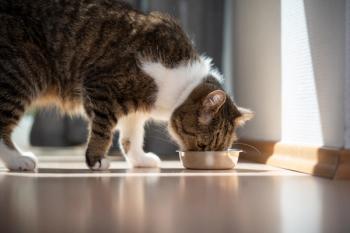
Toxicology Brief: The toxicity of plastic explosives
Reports of dogs ingesting C-4 have come from nine states and, as described here, from as far away as Kandahar, Afghanistan.
Composition C-4 is a high-velocity military plastic explosive. The explosive material in C-4 is cyclotrimethylenetrinitramine (C3H6N6O6), commonly called cyclonite or RDX (royal demolition explosive). It exists as white crystalline powder or crystals. The additive materials are binder, motor oil, and plasticizer. It also contains 2,3-dimethyl-2,3-dinitrobutane (DMDNB), which functions as a chemical marker for security forces.
GETTY IMAGES / STOCKTREK IMAGES
Cyclonite explosive has more explosive power than trinitrotoluene (TNT) does and can be mixed with TNT for aerial bombs, mines, and torpedoes. Cyclonite is also used in the manufacture of smokeless powders and occasionally as a rodenticide, particularly rat poison.1 Cases of recreational abuse of C-4 in people have been reported.2
PHARMACOKINETICS AND TOXICITY
When ingested, cyclonite explosive may cause adverse central nervous system, renal, and gastrointestinal effects.3 Proposed mechanisms of neurologic effects involve alterations of brain cholinesterase activity, decreased monoamine oxidase activity, antagonism of GABA receptors, and down regulation of glutamate signaling pathways.3
A single oral dose of 14 mg/kg of C-4 in an experimental situation was lethal to a dog. The dog developed signs 7.5 hours after exposure and died 18 hours after exposure. Clinical signs included congested mucous membranes, hyperthermia, tachycardia, hyperventilation, intermittent tremors, rigidity, and convulsions. No treatment was provided. It was concluded that the clinical signs of C-4 toxicosis closely resembled those of strychnine poisoning.4
The oral LD50 of cyclonite in rats and mice is highly variable and ranges from 59 to 500 mg/kg. The LD50 of a coarse granular cyclonite is three times higher than that of a fine powder at 100 mg/kg mixed in a solution or slurry.1
Experimental animal studies indicate that cyclonite is absorbed orally but slowly. Based on limited human exposure data, serum cyclonite concentrations appear to correlate with clinical presentation.1
Cyclonite was detected in the serum of a child for more than 120 hours and in the child's stool for 144 hours after ingestion.5 Cyclonite is metabolized by the liver to carbon dioxide, bicarbonate, and formic acid.6 Rat studies indicated that most of a cyclonite dose is excreted in the feces for as long as 21 days after exposure.1 However, studies with radiolabeled RDX in rats suggested that elimination was primarily through exhaled air and urine.3 Information about the half-life of cyclonite is limited. The estimated apparent terminal elimination half-life was reported to be 15.1 hours.5
The most common symptoms in people ingesting C-4 are seizures, spontaneous vomiting, abdominal pain, weakness, dizziness, and headache. Other reported clinical symptoms and laboratory abnormalities included loss of consciousness, renal failure, metabolic acidosis, hypokalemia, and rhabdomyolysis. There are no reports of human fatalities from cyclonite ingestion.1
ANIMAL POISON CONTROL CENTER DATA
The ASPCA Animal Poison Control Center (APCC) consulted on 14 calls regarding exposure of dogs to cyclonite plastic explosives between January 2004 and January 2011. These cases were reported from nine states as well as from a military base abroad (see the sidebar "C-4 ingestion in a military working dog"). No deaths were reported in the APCC database, but not all cases were followed up. Dogs involved were typically state police dogs, explosives-detecting dogs, or military working dogs.7
C-4 ingestion in a military working dog
Signs developed in 57% of the cases. Seizures were seen in 87.5% of animals exhibiting clinical signs. Other clinical signs or laboratory abnormalities included vomiting, acidosis, fasciculations or tremors, harsh respiratory sounds and crackles, elevated liver enzyme activities, hyperesthesia, oral ulcers, tachycardia, polydipsia, and polyuria. Hyperthermia, hyperventilation, dyspnea, transient blindness, and injected and pale mucous membranes were also reported.
DIAGNOSIS
A diagnosis of cyclonite poisoning is based on a history of exposure and the presence of typical clinical signs. Blood cyclonite concentration measurement is not readily available in most clinical settings.
High-performance liquid chromatography can be used to determine plasma concentrations of cyclonite. In five people acutely exposed to cyclonite, plasma concentrations of cyclonite strongly correlated with clinical and laboratory presentation.8 In veterinary medicine, this analysis is uncommon and finding a laboratory to perform it may be difficult.
TREATMENT
If a patient is not exhibiting clinical signs and the exposure is recent, emesis can be induced under veterinary supervision either with hydrogen peroxide (2.2 ml/kg orally, repeat in 10 to 15 minutes if first attempt is unsuccessful) or apomorphine (0.03 mg/kg intravenously or 0.25 mg/kg diluted with saline solution and instilled into the conjunctival sac).9 Because of the putty-like consistency of C-4, it may stay in the animal's stomach for hours before signs develop.
Activated charcoal (1 to 3 g/kg orally) can be administered cautiously as aspiration may occur. Cyclonite is not water soluble, and the aqueous slurry of activated charcoal may have limited benefit.8,10 However, since the absorption of cyclonite is usually delayed, activated charcoal is commonly administered in cyclonite-exposure cases.
There is no specific antidote available for treating cyclonite toxicosis. Treatment is supportive and symptomatic. Close patient monitoring is necessary as seizures may occur rapidly. Seizures are expected to respond to diazepam (0.5 to 2 mg/kg intravenously).9 If seizures persist, phenobarbital (2 to 5 mg/kg) can be given in addition to diazepam. Intravenous fluid therapy at two times the maintenance rate with isotonic crystalloid is recommended. Vomiting can be treated with antiemetics: maropitant (1mg/kg subcutaneously once a day), ondansetron (0.1 to 0.2 mg/kg intravenously b.i.d. to q.i.d.), or metoclopramide (0.2 to 0.5 mg/kg subcutaneously or intravenously t.i.d.).9 Gastrointestinal protectants such as sucralfate (0.25 to 1 g orally t.i.d.) and famotidine (0.5 mg/kg intravenously or subcutaneously one or two times daily) can be given.9
If serious signs develop, monitor the patient's serum chemistry profile, complete blood count, electrolytes, and acid-base status. Clinical signs may last for days. Elevated liver enzyme activities have been reported for weeks beyond the resolution of other signs.6
Hemodialysis has not been shown to reduce C-4 concentrations, shorten the clinical period, or decrease seizure activity.11
PROGNOSIS
The outcome in most cases is expected to be good provided seizures are controlled quickly and no other complications, such as aspiration, develop. Complete recovery with appropriate medical attention is expected in most cases.
Dr. Irina Meadows
Irina Meadows, DVM, DABT
ASPCA Animal Poison Control Center
1717 S. Philo Road, Suite 36
Urbana, IL 61802
REFERENCES
1. Cyclonite. In: POISINDEX System [intranet database]. Greenwood Village, Colo: Thomson Reuters (Healthcare) Inc.
2. Harrell-Bruder B, Hutchins KL. Seizures caused by ingestion of composition C-4. Ann Emerg Med 1995;26(6):746-748.
3. Agency for Toxic Substances and Disease Registry. Toxicologic profile for RDX. Available at:
4. De Cramer KG, Short RP. Plastic explosive poisoning in dogs. J S Afr Vet Assoc 1992;63:30-31.
5. Woody RC, Kearns GL, Brewster MA, et al. The neurotoxicity of cyclotrimethylenetrinitramine (RDX) in a child: a clinical and pharmacokinetic evaluation. J Toxicol Clin Toxicol 1986;24:305-319.
6. Bruchim Y, Saragusty J, Weisman A, et al. Cylonite (RDX) intoxication in a police working dog. Vet Rec 2005;157:354-356.
7. AnTox Database. Urbana, Ill: ASPCA Animal Poison Control Center, 2001-2011.
8. Kucukardali Y, Acar HV, Ozkan S, et al. Accidental oral poisoning caused by RDX (cyclonite): a report of 5 cases. J Intensive Care Med 2003;18(1):42-46.
9. Plumb DC. Plumb's veterinary drug handbook. 7th edition. Ames: Iowa State University Press, 2011;77-79, 304-308, 407-409, 624-626, 677-680, 752-753, 805-809, 943-944.
10. Hollander AI, Colbach EM. Composition C-4 induced seizures: a report of five cases. Mil Med 1969;134(13):1529-1530.
11. Fishkin, R.A., Stanley, S.W., Langston, C.E. Toxic effects of cyclonite (C-4) plastic explosive ingestion in a dog. J Vet Emerg Crit Care 2008;18(5):537-540.
Newsletter
From exam room tips to practice management insights, get trusted veterinary news delivered straight to your inbox—subscribe to dvm360.






